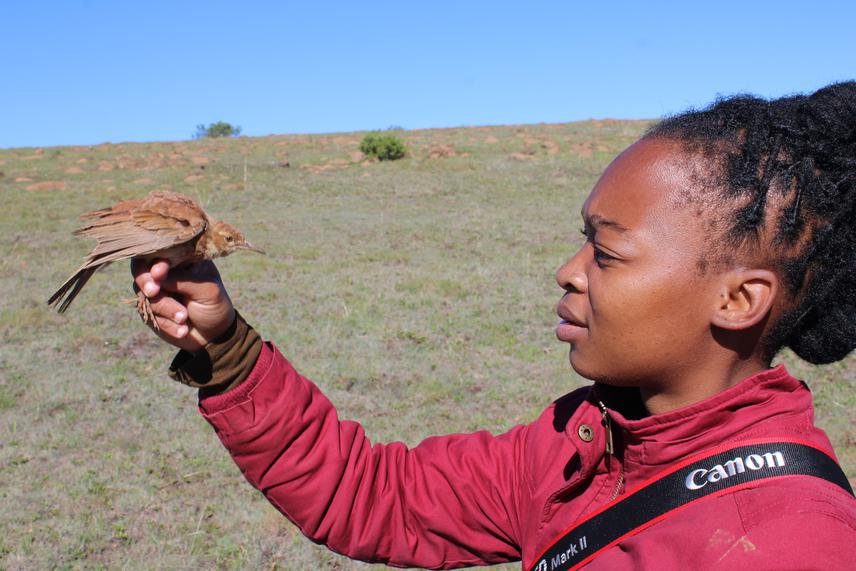Ditiro Judith Moloto
Research question:
What changes or factors are driving the regional declines of lark species?
Aims:
-To investigate extrinsic and intrinsic factors which contribute to the decline of populations of endemic South African lark species.
Specific Objectives:
-To assess the habitat of each of the study species by surveying their area of occupancy.
a) To compare ancient and recent temperatures from areas of occupancy to assess whether climate change has played a role.
-To evaluate their life-history trait in terms of adaptation limitations considering the changing environment.
a) To evaluate the rate of success of their breeding attempts.
b) To evaluate the outcomes of dwelling and nesting on the ground.
c) To assess their diet.
-To assess their genetic diversity and population structure by investigating whether there is a history of inbreeding, hybridisation and introgression.

Eastern long billed Lark.
Larks (Family Alaudidae) are probably the most successful group of passerines that can adapt and survive well in the harshest of environments making them fascinating species. They are distributed globally and known to inhabit environments that range from extreme heat such as the Namib desert to the freezing conditions of the Arctic Tundra. Alaudidae consists of 98 species divided into 21 genera that are found in different biomes. South Africa has 28 species and only nine of these from six genera are strictly endemic.
South African endemic larks occur in grassland and karoo biomes which are listed as the most vulnerable biomes in the country due to various factors. Of the nine South African endemic larks, 11% are listed as Vulnerable, 22% are listed as Endangered while the rest 67% is listed as Least Concern according to the IUCN. Their true numbers in the wild are not known due to lack of research focusing on these birds, hence, the category of Least Concern on the IUCN Red list on most of the species. Globally, lark populations have been declining probably because of numerous anthropogenic and ecological threats that they are faced with in their environments. These threats include habitat loss (which is essential because larks are territorial), climate change, several life-history traits (such as nesting on the ground) and genetic diversity (which is important in terms of adaptation to the changing environment. These factors are detrimental because they may affect diet of the birds, interaction between the birds and their environment, and survival.
This study will investigate the above factors which may contribute to the decline/increase of lark populations in South Africa. These factors will include both intrinsic and extrinsic factors because investigating only one factor may not produce a true reflection of what the underlying factors may be. Populations may face numerous threats such as climate change and habitat loss, therefore, an investigation on both the factors may be crucial. Larks are among the most understudied group of birds including Cisticolas, Pipits and Warblers, thus, there has not been a clear understanding of which specific factors contribute the most to the decline/increase of specific species.
This lack of specific research focusses on karoo and grassland birds has resulted in a gap in terms of information on the species and current population status. Therefore, this project intends to minimise this gap by investigating the decline of South African endemic Larks.